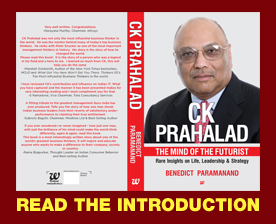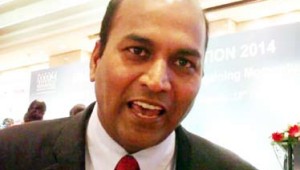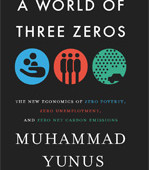 I first learnt about Shombit from Azim Premji. I was the chairman of Wipro’s Sales and Marketing Council at that time (mid to late 1990s) and Azim Premji told me about rebranding Wipro. The Chief Executive Council (CEC) of Wipro had no idea about branding; I had no idea about branding either. Here comes Shombit. My job was made more difficult trying to translate Shombit’s French- Bengali-English into a language that post 50’s men could understand. It was a hell of a torturous task I had to go through for 18 months of our consulting experience with Shombit. But for me, that was a defining period.
I first learnt about Shombit from Azim Premji. I was the chairman of Wipro’s Sales and Marketing Council at that time (mid to late 1990s) and Azim Premji told me about rebranding Wipro. The Chief Executive Council (CEC) of Wipro had no idea about branding; I had no idea about branding either. Here comes Shombit. My job was made more difficult trying to translate Shombit’s French- Bengali-English into a language that post 50’s men could understand. It was a hell of a torturous task I had to go through for 18 months of our consulting experience with Shombit. But for me, that was a defining period.
Shombit talked about stuff like P & P (perceived and potential) research, which was about the brand’s existing value and potential value. It was the first time we heard about doing brand research. After his research, he presented his recommendation to the CEC. People were just stunned to speak, it was obviously very shocking. Premji would never overrule his Executive Council. Shombit was not just there to recommend a brand or brand path and take his fee and go; he was so passionate, he wanted it to be implemented. He wanted a decision then and there. Premji looked around his reportees. They were shocked, silenced and didn’t know how to react. They certainly were not buying the new ideas because they were too radical. So Premji also kept quiet.
Shombit sensed that it was not going anywhere. He really got mad and said, “Azim, if you don’t do this, I’m…., I’m….” he paused, looked around and continued, “I’m going to strip right here!” Premji quickly reacted, “No, no, don’t do that!” Everybody laughed, the ice was broken. That’s Shombit for you. In the mid-1990s, Shombit told me that Indian brands were not yet ready to take on the world. In fact he would always proceed by research, and talk to his potential and existing clients about the importance of research, but Indian corporations, he said, didn’t understand the essence of branding that he evangelized, and were ill equipped to handle the opening of the economy.
Godrej refrigerators with locks
While researching he was shocked to find that every Godrej refrigerator was delivered with a lock and key. Having gone away from India for a very long time, Shombit didn’t understand many things going on here. “Why on earth should a refrigerator have a lock and key?” he queried. Then for a moment he wondered if just like the guy with a hammer who considers the whole world as a nail, lock maker Godrej would put a lock in every damn thing that came its way. The sad realization was that the primary customer for the 165 litre refrigerator was the middle class housewife. I am sorry to say that her biggest concern was that the maidservant would steal and drink milk, so Godrej in its infinite wisdom fulfilled the housewife’s unstated desire to put a lock. This also became a bone of contention and power struggle between mothers-in-law and daughters-in-law.
The interesting thing is that Shombit himself comes from a proletarian background, first in his refugee colony in India then working as a sweeper in socialist France. Looking at the entire principle of human dignity at all levels, not just white collar but across society, it was a matter of great pain for Shombit: “When the maid arrives, why can’t the housewife warm up a glass of milk to give her so that she can take the burden of daily work with full strength? Why can’t it be like that rather than lock the refrigerator?” asks Shombit.
If you look at Shombit’s progression and his current book, it’s quite phenomenal that he has evolved cerebrally as a writer. You must be wondering about the thought process behind the book, his approach to branding, to understanding consumer behavior, his whole take on life and living, and understanding where it all begins. The book is phenomenal, an exploration of many issues for you to read.
How Shombit’s mind works?
How does Shombit’s mind work? I have seriously been flummoxed and surprised, sometimes shocked, not just today, and tried to decode what goes on in his head. If you look at the audience here, you would find the biggest head is Shombit’s. The other man who had a big head that stood out was CK Prahalad’s, both fundamentally because of the size of their brain.
There’s a lot of research going on about how people think. Why does Shombit think like this and others don’t? This brings us to the idea of how thoughts happen to begin with. If you look at Shombit’s brain and your and my brain, what’s common is the primitive brain which is the amygdala. Now this is the intuitive brain, the primordial brain that does not see in alpha numeric characters. We are factory fitted and shipped into this world with the primitive brain that’s fully formed in the mother’s womb. It basically interprets sight, sounds, movement and color. That’s why Shombit’s clothes are so colorful like what he’s wearing.
Above that is the neocortical brain which keeps growing until you are about 8 years. The neocortical brain has two sides: the left brain is logical; the right brain sees patterns. If you look at Shombit’s whole approach and thought process with ours, we engage one part of the brain at a time when looking at something. Some get triggered by the emotive primitive brain. Some people rationalize. That’s neocortical brain thinking, the left, logical side; the right has the relational brain. But the way I have seen Shombit working, his entire brain lights up at the same time. That is something you will experience when you read his new book – Strategic Pokes.
Once you understand how his brain works, that he is simultaneously using left brain and right brain, neocortical and primitive, there is no need for sophistication because he is continuously thinking the same way. He is not trying to sugar-coat something nor is he trying to say something which sounds good. He will say just what comes as it processes in his mind. That is a very fascinating, powerful thing.
Of late what is happening is that branding, which was considered witchcraft, is becoming more scientific. People understand how the human mind works, which is basically a function of four kinds of people sitting together: the neuroscientist, psychologist, the geneticist and fourthly the whole imaging technology. Now with this I think people like Shombit will gain significant currency.
India’s future lies with no-collar working class
Another significant thing in this book is the way he desperately tries to draw attention to the fact that India will not succeed unless people who are neither blue collar nor white collar, the in-between category, they become world class. If you walk into an electronic showroom today, the person presenting the product doesn’t even know what goes inside the product. That’s social failure of the same kind as the lock and key for the refrigerator. Society is not questioning why. This book is an urgent call for policy makers, thinkers and industrialist to actually pay attention to that human capital.
Strategic Pokes is a call to action for those hiring the salesman in the electronic shop, the bespoke tailoring guy, technicians of various sorts and other in-between categories. Those in authority have to bring a level of training, understanding and capacity building.
The book is about challenging Indian social thinking, asking that we disengage with our traditional way of looking at the sense of fairness. People imagine branding is about advertising or marketing. Actually Shombit’s branding builds a value centric company in a society where consumers ask a question and industry responds with something valuable. In this book, Shombit is basically asking policy makers, thinkers, teachers, students and certainly the industry to re-think their priorities.
Edited Excerpts of Subroto Bagchi’s (author & Chairman of MindTree ) comments at the launch of Shombit Sengupta’s book Strategic Pokes – Be Disruptive to Achieve Quantum Business Benefit in Bangalore recently.











Recent Comments